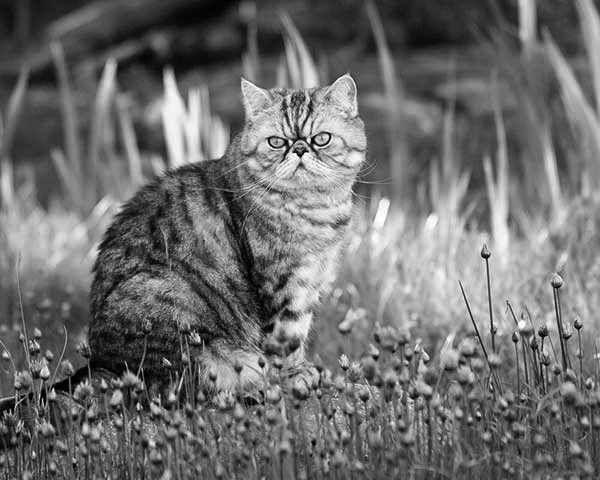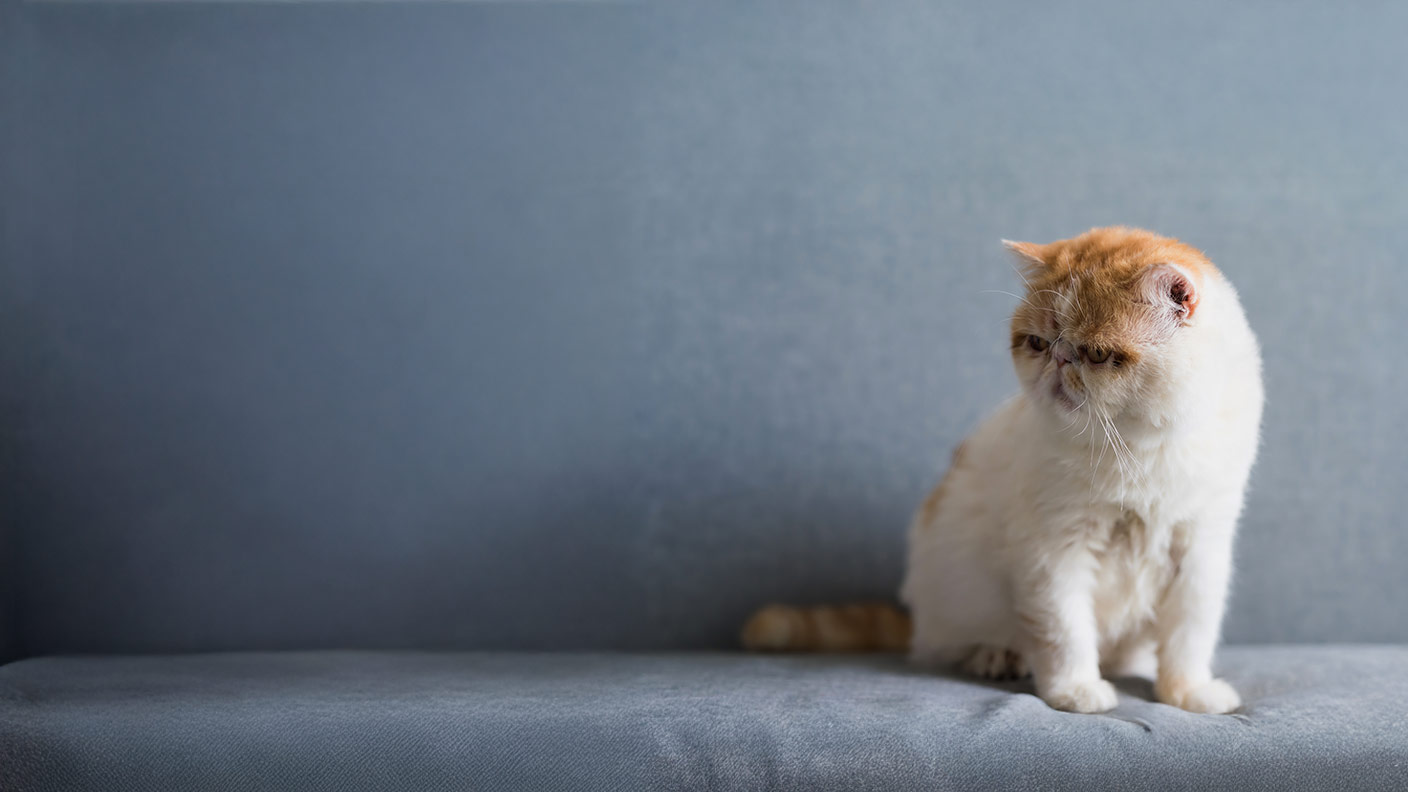Exotic Shorthair cat breed information and advice
The Exotic Shorthair breed was developed in the USA in the 1960s. The aim was to create a shorthaired version of the Persian by crossing an American Shorthair with a silver Persian. Initially intended to be silver only, the breed was named the Sterling breed. The name was changed to the Exotic Shorthair after Burmese and Russian Blue cats were used to cross with Persians and all colours were accepted.
In the UK, British Shorthairs were used to cross with longhaired Persians. After the initial outcrosses, the offspring are only allowed to be bred with Persians. Exotic Shorthairs are a relatively new breed that is gaining in popularity. Find out how to love and care for Exotic Shorthair breeds in our guide.
Exotic Shorthair cat facts

| Lifespan | 12-15 years |
| How much | £450 + |
| Size | medium to large |
| Weight | 3.5 - 6 kg |
| Grooming | low |
| Temperament | easy-going, friendly, affectionate, playful |
| Exercise | low |
Insurance for your Exotic Shorthair
The Exotic Shorthair can have several breed-related problems owing to their Persian ancestry. Like Persian cats, they are flat faced (brachycephalic) which means they can be prone to a variety of conditions. Getting your Exotic Shorthair cat insurance will help with the cost of any treatment that your cat may need for illness or injury and help cover the cost of surgery.
Sainsbury’s Bank Pet Insurance
Sainsbury’s Bank Pet Insurance is available to Exotic Shorthair cats from 8 weeks of age.
How to care for an Exotic Shorthair cat
Exotic Shorthairs like all cat breeds, should be looked after, fed a balanced diet and given the chance to exercise to keep them as healthy as they possibly can be. Here are some tips on how to look after your cat.
Feeding and nutrition
Always feed your Exotic Shorthair a nutritious, balanced diet. There are lots of different types of cat food available and the breeder you bought your Exotic from will let you know what they’ve been feeding them. If you’re still struggling to find the right brand for your cat, you can ask your vet for their recommendation. Given an Exotic Shorthair’s natural build, they can sometimes look like a fat cat, but that may not always be the case. Just make sure that you don’t overfeed them or give them too many treats or you may end up with one.
Grooming
Exotic Shorthair cats have short coats with a soft, dense undercoat. Their coats can come in all colours and patterns. Compared to the Persian, they’re low maintenance. They’ll just need grooming with a brush, comb or grooming glove once a week. More grooming will be needed during the shedding seasons of spring and autumn.
Exotic Shorthairs have flat faces, which means their tear ducts don’t drain properly and can overflow. Tears running down their faces can cause staining, so use a damp cloth to wipe their faces and remove the stains. Clean their eyes and ears regularly but only give them an occasional bath, if they get very dirty. Their teeth should also be brushed regularly to prevent dental disease.
Exercise
Exotic Shorthairs have low exercise needs, but this doesn’t mean that they don’t enjoy playing. Provide them with lots of interactive toys to keep them busy and a perch or cat tree for climbing. They’ll also like a sunny windowsill to sit on and watch the world go by, but their favourite place though is likely to be your lap.
Training
Exotic Shorthairs are intelligent and will understand the meaning of ‘no’. Toilet or litter training will be picked up quickly. Always provide at least one litterbox per cat and make sure that these are kept clean.
Temperament and behaviour
Exotic Shorthairs are gentle and affectionate and love to be near their owner and follow you around the house. They’ll always be ready to curl up on your lap for a cuddle or nap. Their Shorthair ancestry means that they also like to play (making them livelier than Persians). Make sure you provide them with interactive toys and spend time playing together. They’re happy to lead a quiet life indoors. This doesn’t mean that they have given up their prey drive – you’ll find some to be good mouse hunters.
Common health problems
As Exotic Shorthairs have Persian ancestry, they can be susceptible to a few breed-related problems. Like their Persian relatives, they have shortened, flattened faces and their faces can look squashed or pushed in. This feature is known as being brachycephalic. Unfortunately, this can lead to jaw deformities, small nostrils, and a small soft palate. Breathing difficulties, dental malocclusion, excessive tearing and eye problems such as entropion (where the eyelid folds inwards) and cherry eye can occur. Taking out Exotic Shorthair cat insurance will mean that any health issues that your Exotic Shorthair may suffer from will be covered, as long as your policy is in place before a condition is known.
Autosomal Dominant Polycystic kidney disease (AD-PKD)
Autosomal dominant polycystic kidney disease (AD-PKD or PKD) is an inherited condition that can affect the Exotic Shorthair. The condition causes cysts to form in the kidneys. Most cats are around 7 years when they start to show signs of the condition. There’s no cure, but some treatments may help to improve their quality of life. Affected cats should not be allowed to breed. A DNA test can identify cats that carry the gene responsible for the condition. Make sure that your breeder has removed any cats with the gene from their breeding lines.
Brachycephalic upper airway obstruction
Brachycephalic upper airway obstruction syndrome (BAOS) is caused by selective breeding from breeders wanting to develop a cat with a shorter nose and a flat face. As a result of breeding for this feature, Exotic cats may show signs of breathing problems. They may also have problems with their eyes and skin and are more likely to need a caesarean section when they give birth. Affected cats should not be bred from, even if they have had surgery to correct any defects.
Epiphora
Exotic Shorthairs can be affected by epiphora. This is a condition where there is an overflow of tears from the eye. Their flat faces prevent the tears from draining properly into the tear ducts. Wiping the eyes daily will prevent staining of the coat.
Dental malocclusion
Brachycephalic breeds such as the Exotic Shorthair can suffer dental problems resulting from overcrowding of the teeth due to a shortened jaw. Their teeth should be cleaned daily and some cats may need teeth removed.
So, is an Exotic Shorthair cat right for you?
The Exotic Shorthair is ideal if you like the look of a Persian breed but don’t want a long-haired cat. If you want an affectionate lap cat, this is the breed for you. They don’t like to be left alone too long and prefer to be indoors. Their easy-going and gentle nature means that they make great pets for families with children, other cats, and cat-friendly dogs.
Frequently asked questions
How big do Exotic Shorthair cats get?
Exotic Shorthairs are medium to large cats. They can look chunky due to their heavy bone structure and thick fur. Females weigh between 3.5-5 kg, while males can weigh over 5.5 kg. They have fairly short legs.
Can Exotic Shorthairs go outside?
Exotic Shorthair cats can go outside if you have a safe, enclosed area. However, they are home-loving breeds and are happy to be indoor cats.
How long do Exotic Shorthairs live?
The average lifespan of an Exotic Shorthair is 12-15 years. This will depend on how well they’re cared for and whether they’re free from any inherited conditions.
Browse our guides

Choose from our list of helpful guides and information
Explore dog breeds

Find out how to keep your dog healthy and happy
Cat breed guides

How to care for your cat, common health problems and more
References
Content provided from Vetstream's Vetlexicon Felis - www.vetstream.com/treat/felis
Vetstream Ltd (online) Exotic Shorthair. In: Vetlexicon Felis. Vetstream Ltd, UK. Website: https://www.vetstream.com/treat/felis/freeform/exotic-shorthair.
Martha Cannon, Rachel Korman (online) Kidney: autosomal dominant polycystic disease. In: Vetlexicon Felis. Vetstream Ltd, UK. Website: https://www.vetstream.com/clinical-reference/felis/diseases/kidney-autosomal-dominant-polycystic-kidney-disease.
Vetstream Ltd (online) Autosomal dominant polycystic kidney disease Owner Factsheet. In: Vetlexicon Felis. Vetstream Ltd, UK. Website: https://www.vetstream.com/treat/felis/owner-factsheets/polycystic-kidney-disease.
Vetstream Ltd (online) Brachycephalic airway obstruction. In: Vetlexicon Felis. Vetstream Ltd, UK. Website: https://www.vetstream.com/treat/felis/diseases/brachycephalic-airway-obstruction.
Vetstream Ltd (online) Brachycephalic upper airway obstruction syndrome (BUAOS) Owner Factsheet. In: Vetlexicon Felis. Vetstream Ltd, UK. Website: https://www.vetstream.com/treat/felis/owner-factsheets/brachycephalic-upper-airway-obstruction-syndrome-(buaos).
Dennis E Brooks, Paul Evans, Newman Lorna, Philip K Nicholls, David Williams (online) Epiphora. In: Vetlexicon Felis. Vetstream Ltd, UK. Website: https://www.vetstream.com/treat/felis/diseases/epiphora.
Alexander M Reiter (online) Dental malocclusion. In: Vetlexicon Felis. Vetstream Ltd, UK. Website: https://www.vetstream.com/clinical-reference/felis/diseases/dental-malocclusion.
Terms and conditions
Important information
* Guaranteed discount for Nectar members: The discount is based on information related to you and the transactions you've made with Sainsbury's supermarkets and Sainsbury's Bank using your Nectar card. For more information go to sainsburysbank.co.uk/nectar.
Sainsbury's Bank plc, Registered Office, 33 Charterhouse Street, London, EC1M 6HA (registered in England and Wales, no 3279730) is authorised by the Prudential Regulation Authority and regulated by the Financial Conduct Authority and the Prudential Regulation Authority (register no. 184514).
Sainsbury's Supermarkets Ltd is an appointed representative of Sainsbury's Bank plc. Sainsbury's Bank plc acts as an introducer to Pinnacle Insurance Ltd who is authorised by the Prudential Regulation Authority and regulated by the Financial Conduct Authority and the Prudential Regulation Authority (register number 110866). Registered office: 4th Floor, Limelight, Elstree Way, Borehamwood, Hertfordshire, WD6 1JH. Sainsbury’s Bank Pet Insurance is arranged, administered and underwritten by Pinnacle Insurance Ltd. Sainsbury's Bank plc and Pinnacle Insurance Ltd are not part of the same corporate group.
We do not provide personal recommendations to customers.
